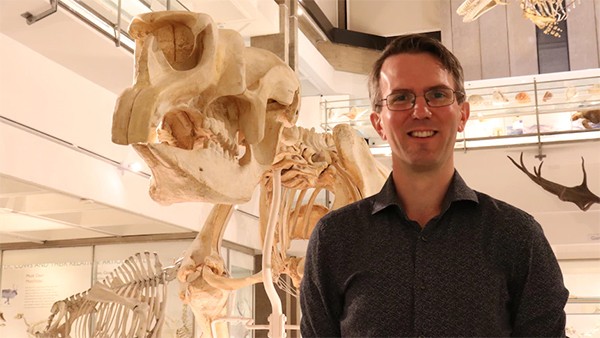Juvenile Tasmanian tiger specimens, or thylacines, preserved in jars. (Supplied: Tasmanian Museum and Art Gallery).
Zoe Kean and Lucie Cutting, Should the Tassie tiger be brought back to life? Have your say, ABC Radio Hobart, 2 February 2023
Scientists think they can bring thylacines back to life within the next decade and the ABC is collecting your vote, your insights and questions about this de-extinction project.
There is a plan to edit the genome of a related species — the dunnart — to resemble the thylacine’s DNA, then use another relative as a surrogate to gestate the reincarnated baby thylacines.
Before you have your say, read the perspectives of four experts from diverse fields, then add your voice.
Yes, bring it back!
Consultation with Aboriginal people “from the very start of it” is a priority for Rodney Dillon, chairperson of the Aboriginal Heritage Tasmania, who says the team reconstructing the thylacine does not own what they aim to create.
“It was taken away from us without us having a say in it. I think it would be good for us, as part of our culture, to have this icon back,” Mr Dillon says
“When we think of thylacines, they were part of our family. Our people lived with thylacines for over 50,000 years.
“It’s good they’re helping to get it back, but it’s important for them to know who it belongs to.”

Mr Dillon envisions the release of the lab-grown thylacine beyond Tasmania, citing evidence of the creature’s earlier distribution.
“There are indications it was up in the north-west [of mainland Australia],” he says.
“Those people would feel a belonging to it too. It’s just they lost it earlier than we did.”
Professor of Environmental Sustainability at the University of Tasmania, Barry Brook, also supports its return.
“The thylacine used to be a very important part of the Tasmanian ecosystem and had been for thousands, probably millions of years. Restoring that would, I think, restore ecosystem function,” he says.
He says the return of this iconic Tasmanian species may suppress feral cats.
“There’s evidence on the mainland that dingoes suppress cat numbers; thylacines could probably play a similar role,” Professor Brook says.

He says the cloned animal would not have to be an exact genetic replica of the Tasmanian tiger.
“As long as it’s a functional organism that effectively fulfils the same sort of ecological role,” he says.
“If it were a wild animal again, back in the ecosystem, it would be the biggest tourism drawcard you could ever imagine for Tasmania.”
No, don’t even try!
Bringing back the thylacine is not possible and should not be attempted, according to Jack Ashby, assistant director of the Museum of Zoology at Cambridge University.
“I don’t believe it’s possible to go from a theoretical genome on a computer screen to a viable embryo of a real species, particularly by editing the genome of such a distantly related animal as a dunnart,” Dr Ashby says.
“To say you can go from a 5cm-long animal to a 20-kilo thylacine is crazy.”

Dr Ashby is sceptical of claims that the genetic technologies invented for the project would have broader conservation benefits or be preferable to proven methods such as habitat protection, restoration, and controlling invasive species.
He also has concerns about the welfare of the animals that would be used in the project.
“There are going to be a lot of misses on the way where animals will have died and that’s a big deal if unlikely to work in the first place,” Dr Ashby says.
He’s also worried that attempting to revive the thylacine may make us more apathetic about extinction.
“The message that extinction is forever is fundamentally undermined by even starting this project,” he says.
“That’s a really dangerous message, particularly when it’s likely to be impossible.”
Proceed with caution
It is important that the community have an informed discussion about reviving the species so if the decision is made to bring it back it can thrive, says futurist Sinead Bovell.
“If we could do it right now, I don’t think we’re ready,” she says.

“The last thing we want to do is go down this route and then realise that we’re just on the path to extinction again because we haven’t got our act together.
“There are really important points in the science to consider, it’s a really worthwhile conversation … so I’m pro keeping these conversations moving forward.”
Ms Bovell emphasises that the scientists involved should communicate openly and clearly with the public, including “what it is that they’re working on, who is funding it, and why they believe it is important”.
That’s a snapshot of four key perspectives in this de-extinction debate. Now it’s over to you. Add your vote, your questions and insights to the ABC’s coverage.
Should thylacines make a comeback? Click here to give your opinion.

